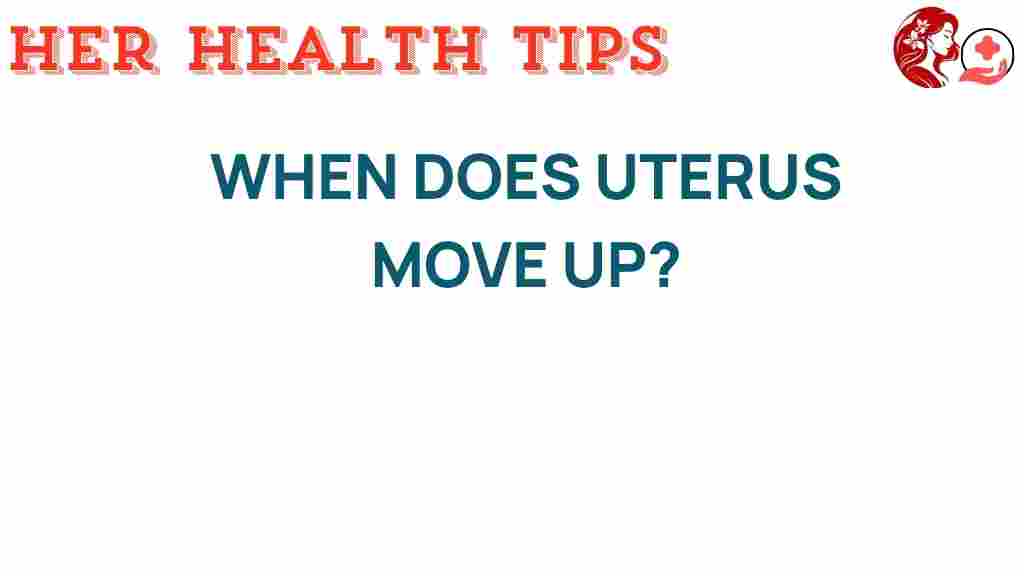Discovering the Uterus: When Does It Shift Position?
The uterus is a remarkable organ at the center of women’s health, playing a crucial role in the reproductive system. Understanding its anatomy and function can help demystify many aspects of women’s health, particularly during the menstrual cycle and pregnancy. One fascinating aspect of the uterus is its ability to shift position. In this article, we’ll explore when and why this movement occurs and its implications for women’s health.
The Anatomy of the Uterus
The uterus, often referred to as the womb, is a hollow, muscular organ located in the pelvis. It is shaped like an inverted pear and has three main parts:
- Fundus: The upper part, where the fallopian tubes connect.
- Body: The main part of the uterus, where a fertilized egg implants and grows.
- Cervix: The lower, narrow part that opens into the vagina.
The uterus is supported by the pelvic floor muscles, which play a vital role in maintaining its position. Understanding the anatomy of the uterus is essential for recognizing how its position can change due to various factors.
Why Does the Uterus Shift Position?
The uterus can shift position for several reasons, including:
- Menstrual Cycle: Hormonal fluctuations during the menstrual cycle can cause the uterus to enlarge slightly and shift.
- Pregnancy: As the uterus expands to accommodate a growing fetus, its position changes significantly.
- Pelvic Floor Health: Weakness or tension in the pelvic floor muscles can lead to changes in the position of the uterus.
- Physical Activity: Certain movements and exercises can temporarily shift the uterus.
Understanding these factors can help in recognizing normal changes and identifying potential health issues.
When Does the Uterus Shift Position?
Several key life stages and conditions can influence the position of the uterus:
1. During the Menstrual Cycle
Throughout the menstrual cycle, the uterus undergoes various changes. In the first half of the cycle, estrogen levels rise, leading to a thickening of the uterine lining. This can cause the uterus to shift slightly upward. In the latter half, as the body prepares for a potential pregnancy, progesterone levels increase, which can also affect uterine position.
2. During Pregnancy
Pregnancy is one of the most significant times when the uterus shifts position. As the fetus grows, the uterus expands from its normal size of about 3 inches long to over a foot long by the end of the pregnancy. This expansion causes it to move upward and outward, impacting nearby organs and structures.
3. Postpartum Changes
After childbirth, the uterus gradually returns to its pre-pregnancy size and position. This process, known as involution, is typically complete within six weeks postpartum. However, some women may experience lingering changes in uterine position due to the effects of childbirth on the pelvic floor.
4. Pelvic Floor Dysfunction
The pelvic floor muscles support the uterus, bladder, and bowel. Weakness or dysfunction in these muscles can lead to pelvic organ prolapse, where the uterus may shift downward into the vaginal canal. This condition can cause discomfort and various health issues.
Step-by-Step Guide: Understanding Uterine Position Changes
To better comprehend how the uterus shifts position, follow this simple guide:
- Step 1: Monitor your menstrual cycle. Note any changes in symptoms, such as cramping or bloating.
- Step 2: Pay attention to physical activities. Certain exercises may cause temporary shifts in the uterus.
- Step 3: During pregnancy, consult with your healthcare provider about changes in your body and how the uterus is positioned.
- Step 4: After childbirth, monitor your recovery and any changes in your pelvic floor health.
By following these steps, you can gain a better understanding of your body’s changes and maintain optimal women’s health.
Troubleshooting Uterine Position Concerns
If you experience unusual symptoms related to uterine position, consider the following troubleshooting tips:
- Consult a Healthcare Provider: If you notice significant pain, discomfort, or unusual bleeding, seek medical advice.
- Pelvic Floor Exercises: Strengthening your pelvic floor can help support the uterus and prevent prolapse.
- Monitor Symptoms: Keep a journal of your symptoms and any changes in your menstrual cycle or during pregnancy.
For more detailed information and support, you can visit this resource for women’s health.
The Importance of Uterus Awareness in Women’s Health
Understanding the anatomy and movement of the uterus is vital for women’s health. Awareness can empower women to recognize normal changes and seek help when necessary. Here are some key points to remember:
- Regular Check-Ups: Routine gynecological exams can help track changes in uterine position and overall reproductive health.
- Healthy Lifestyle Choices: Maintaining a balanced diet and regular exercise can promote pelvic floor health.
- Be Informed: Educate yourself about your body and the menstrual cycle to better understand normal variations.
Conclusion
In conclusion, the uterus is a dynamic organ that plays an essential role in women’s health and the reproductive system. Understanding when and why the uterus shifts position can help women navigate their health more effectively. Whether it’s during the menstrual cycle, pregnancy, or postpartum recovery, awareness of these changes is crucial. By staying informed and proactive regarding pelvic floor health and uterine position, women can enhance their overall well-being.
For further exploration of women’s health topics, consider visiting this external link for comprehensive articles and resources.
This article is in the category Reproductive and created by HerHealthTips Team
